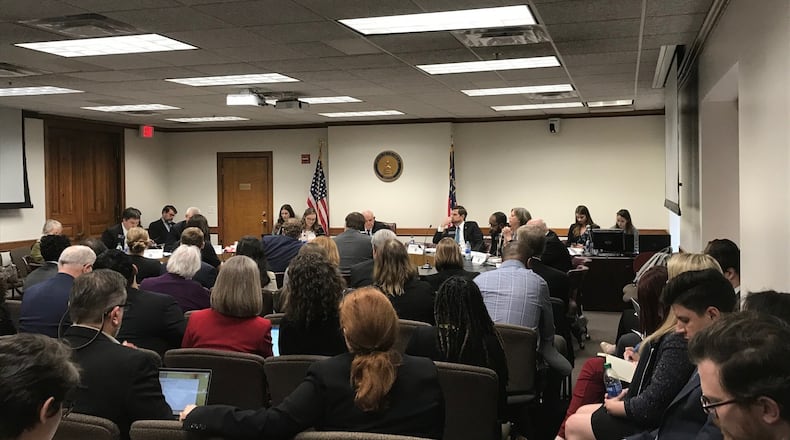For a second year, Gov. Brian Kemp, through his legislative leaders, has pitched a plan aimed at cutting costs and streamlining Georgia’s dual enrollment program.
House Bill 444, rewritten this week after a prior version introduced last year was put on hold, would restrict students to a total of 30 college credit hours, and would limit the program to only 11th and 12th grade students, with few exceptions.
Students who want to take additional courses after reaching the 30 credit hour limit would pay for the classes themselves. Officials said dual enrollment students take an average of 17 credit hours. Currently, they can take up to 15 credit hours a semester.
Another change: A student who withdraws from two courses would be dropped from the program unless they get special approval.
Dual enrollment, which allows students to take college courses and earn college credits while still in high school, is one of the state’s most popular education initiatives. Since its beginning almost three decades ago, it has been touted as a way to give high school students an early start on college and save parents money.
Enrollment has nearly doubled in a recent four-year stretch, from about 27,000 students in fiscal year 2016 to nearly 52,000 students in fiscal year 2019, state records show. Georgia’s fiscal year begins July 1 and ends June 30.
As enrollment has increased, so, too, have costs. A 2018 state audit found general fund spending for the dual enrollment program increased by more than 325% over the prior five years. The 2019 fiscal year budget was about $105 million.
State leaders said the costs could rise to more than $140 million by the 2021 fiscal year. They hope to keep costs at $100 million.
“It is the fastest-growing budget in the state of Georgia by a long shot,” House floor leader Bert Reeves, a Republican from Marietta, told the Georgia Senate’s Higher Education Committee, where the changes were discussed Wednesday.
Reeves told lawmakers there have been isolated instances where students have taken Zumba fitness classes funded through dual enrollment. Committee chairman Sen. Lindsey Tippins, R-Marietta, believes the changes will bring a “more thoughtful approach” from students about what courses to take.
Dual enrollment began in 1992 as a way for high school students to take college courses, earning college credits. The state pays the public or private college where the student is taking the class. The average credit hour cost at most Georgia regional and state universities ranges between $169 and $182.
Students can take courses in a wide range of subjects such as accounting, chemistry, information technology, psychology and welding. About three-quarters of credit hours are in core subjects such as math and English. About 60% of dual enrollment students are taking courses in Technical College System of Georgia schools.
State leaders have sought solutions to curb spending for the program, and to ensure students are taking courses that fit their interests and not taking too many classes.
In May, Georgia Student Finance Commission board members approved a plan to plug a $25 million budget gap in the dual enrollment program by passing along the costs for student books and fees to colleges and universities providing the courses.
Kemp, who took office last year, has been concerned about the state’s finances. He ordered state agencies several months ago to cut spending 4% this fiscal year and 6% next year. The governor is scheduled to release his budget Thursday.
The changes would likely impact rural students most, since rural school districts have a harder time recruiting teachers for Advanced Placement courses. That causes more students to seek dual enrollment courses at local colleges.
Decatur resident Bert Bee-Lindgren and his two children, Aubrey and Max, attended the meeting and discussed their concerns about the proposed cuts with Reeves. The children, both students at Decatur High School, are taking dual enrollment courses and say they have benefited from the rigor and flexibility of those classes.
They agree there should be a cap of credit hours, but there should be exceptions for high-achieving students. Their father suggested the state could cover 80% of the costs for upper-income students.
“There should be a path to challenge high-achieving students,” he said. “(The bill is) not standing up to our commitment to educate our students.”
State officials believe the changes could save at least $15 million in the first year.
The bill would steer students toward taking courses in those core courses, such as math, science and English. Kemp’s office met after last year’s session with education leaders and groups to discuss the changes. One of those groups was the Georgia Independent Colleges Association. Its president, Susanna Baxter, attended Wednesday’s meeting and said she supported the changes.
Sen. Nan Orrock, D-Atlanta, said afterward it was “rational to put a reasonable cap on the state’s investment” in the program, but she wanted to hear more from students and parents about the changes.
The committee is scheduled to vote on the bill Thursday.
Dual Enrollment Growth
The number of students in Georgia’s dual enrollment program has grown by 89% in the past four fiscal years, and the program’s budget has grown by 115% over that time period. Here’s a breakdown of how the program has grown. (Georgia’s fiscal year begins July 1 and ends June 30.)
Year; Students; Budget
2016; 27,461; $48,683,075
2017; 35,925; $68,504,548
2018; 43,635; $86,327,762
2019; 51,928; $104,642,283
Source: Georgia Student Finance Commission
About the Author
Keep Reading
The Latest
Featured



